
List of adaptive radiated marsupials by form
Encyclopedia
This is a list of adaptive radiated marsupial
s by form; they are adaptively radiated
marsupial
species equivalent to the many niche-types of non-marsupial mammal
s. Many of the surviving species are from Australia
. There are unique types, for example the extinct
genus Nototherium
, a 'rhinoceros
-type'.
The new world has the common opossum, also a unique form.
Even before the mid-19th century and Charles Darwin
's time, biogeographer
s understood speciation
and animal niches. A supreme example that became aware to Darwin as sailing ships traveled the world is the New Zealand
flightless, ground-dwelling, worm-eating kiwi
, a bird, but a species in a mammal-niche.
)
(2 subspecies)
2 surviving genera
Marsupial
Marsupials are an infraclass of mammals, characterized by giving birth to relatively undeveloped young. Close to 70% of the 334 extant species occur in Australia, New Guinea, and nearby islands, with the remaining 100 found in the Americas, primarily in South America, but with thirteen in Central...
s by form; they are adaptively radiated
Adaptive radiation
In evolutionary biology, adaptive radiation is the evolution of ecological and phenotypic diversity within a rapidly multiplying lineage. Starting with a recent single ancestor, this process results in the speciation and phenotypic adaptation of an array of species exhibiting different...
marsupial
Marsupial
Marsupials are an infraclass of mammals, characterized by giving birth to relatively undeveloped young. Close to 70% of the 334 extant species occur in Australia, New Guinea, and nearby islands, with the remaining 100 found in the Americas, primarily in South America, but with thirteen in Central...
species equivalent to the many niche-types of non-marsupial mammal
Mammal
Mammals are members of a class of air-breathing vertebrate animals characterised by the possession of endothermy, hair, three middle ear bones, and mammary glands functional in mothers with young...
s. Many of the surviving species are from Australia
Australia
Australia , officially the Commonwealth of Australia, is a country in the Southern Hemisphere comprising the mainland of the Australian continent, the island of Tasmania, and numerous smaller islands in the Indian and Pacific Oceans. It is the world's sixth-largest country by total area...
. There are unique types, for example the extinct
Extinction
In biology and ecology, extinction is the end of an organism or of a group of organisms , normally a species. The moment of extinction is generally considered to be the death of the last individual of the species, although the capacity to breed and recover may have been lost before this point...
genus Nototherium
Nototherium
Nototherium is an extinct genus of marsupial. This mammal had hypsodont molars. It was a relative of the larger Diprotodon and a distant kin to modern wombats too...
, a 'rhinoceros
Rhinoceros
Rhinoceros , also known as rhino, is a group of five extant species of odd-toed ungulates in the family Rhinocerotidae. Two of these species are native to Africa and three to southern Asia....
-type'.
The new world has the common opossum, also a unique form.
Even before the mid-19th century and Charles Darwin
Charles Darwin
Charles Robert Darwin FRS was an English naturalist. He established that all species of life have descended over time from common ancestry, and proposed the scientific theory that this branching pattern of evolution resulted from a process that he called natural selection.He published his theory...
's time, biogeographer
Biogeography
Biogeography is the study of the distribution of species , organisms, and ecosystems in space and through geological time. Organisms and biological communities vary in a highly regular fashion along geographic gradients of latitude, elevation, isolation and habitat area...
s understood speciation
Speciation
Speciation is the evolutionary process by which new biological species arise. The biologist Orator F. Cook seems to have been the first to coin the term 'speciation' for the splitting of lineages or 'cladogenesis,' as opposed to 'anagenesis' or 'phyletic evolution' occurring within lineages...
and animal niches. A supreme example that became aware to Darwin as sailing ships traveled the world is the New Zealand
New Zealand
New Zealand is an island country in the south-western Pacific Ocean comprising two main landmasses and numerous smaller islands. The country is situated some east of Australia across the Tasman Sea, and roughly south of the Pacific island nations of New Caledonia, Fiji, and Tonga...
flightless, ground-dwelling, worm-eating kiwi
Kiwi
Kiwi are flightless birds endemic to New Zealand, in the genus Apteryx and family Apterygidae.At around the size of a domestic chicken, kiwi are by far the smallest living ratites and lay the largest egg in relation to their body size of any species of bird in the world...
, a bird, but a species in a mammal-niche.
Anteater-like
1 genus–(monotypicMonotypic
In biology, a monotypic taxon is a taxonomic group with only one biological type. The term's usage differs slightly between botany and zoology. The term monotypic has a separate use in conservation biology, monotypic habitat, regarding species habitat conversion eliminating biodiversity and...
)
(2 subspecies)
| Anteater Anteater Anteaters, also known as antbear, are the four mammal species of the suborder Vermilingua commonly known for eating ants and termites. Together with the sloths, they compose the order Pilosa... -like marsupials |
||||
|---|---|---|---|---|
| Taxa | Presence | Notes | Images | |
Marsupial Marsupial Marsupials are an infraclass of mammals, characterized by giving birth to relatively undeveloped young. Close to 70% of the 334 extant species occur in Australia, New Guinea, and nearby islands, with the remaining 100 found in the Americas, primarily in South America, but with thirteen in Central... : (anteater-like)
|
Western Australia Western Australia Western Australia is a state of Australia, occupying the entire western third of the Australian continent. It is bounded by the Indian Ocean to the north and west, the Great Australian Bight and Indian Ocean to the south, the Northern Territory to the north-east and South Australia to the south-east... (2 subspecies) |
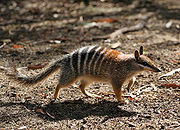 |
||
Cat-like
1 genus–(6 species)| Cat Cat The cat , also known as the domestic cat or housecat to distinguish it from other felids and felines, is a small, usually furry, domesticated, carnivorous mammal that is valued by humans for its companionship and for its ability to hunt vermin and household pests... -like marsupials |
||||
|---|---|---|---|---|
| Taxa | Presence | Notes | Images | |
Marsupial Marsupial Marsupials are an infraclass of mammals, characterized by giving birth to relatively undeveloped young. Close to 70% of the 334 extant species occur in Australia, New Guinea, and nearby islands, with the remaining 100 found in the Americas, primarily in South America, but with thirteen in Central... : (cat-like)
|
Australia Australia Australia , officially the Commonwealth of Australia, is a country in the Southern Hemisphere comprising the mainland of the Australian continent, the island of Tasmania, and numerous smaller islands in the Indian and Pacific Oceans. It is the world's sixth-largest country by total area... & Papua and New Guineas |
 |
||
Groundhog-like
6 genera2 surviving genera
| Groundhog Groundhog The groundhog , also known as a woodchuck, whistle-pig, or in some areas as a land-beaver, is a rodent of the family Sciuridae, belonging to the group of large ground squirrels known as marmots. Other marmots, such as the yellow-bellied and hoary marmots, live in rocky and mountainous areas, but... -like marsupials |
||||
|---|---|---|---|---|
| Taxa | Presence | Notes | Images | |
Marsupial Marsupial Marsupials are an infraclass of mammals, characterized by giving birth to relatively undeveloped young. Close to 70% of the 334 extant species occur in Australia, New Guinea, and nearby islands, with the remaining 100 found in the Americas, primarily in South America, but with thirteen in Central... : (groundhog-like)
|
|
|||
Mole-like
1 genus–(2 species)| Mole Mole (animal) Moles are small cylindrical mammals adapted to a subterranean lifestyle. They have velvety fur; tiny or invisible ears and eyes; and short, powerful limbs with large paws oriented for digging. The term is especially and most properly used for the true moles, those of the Talpidae family in the... -like marsupials |
||||
|---|---|---|---|---|
| Taxa | Presence | Notes | Images | |
Marsupial Marsupial Marsupials are an infraclass of mammals, characterized by giving birth to relatively undeveloped young. Close to 70% of the 334 extant species occur in Australia, New Guinea, and nearby islands, with the remaining 100 found in the Americas, primarily in South America, but with thirteen in Central... : (mole-like)
|
 |
|||
Rhinoceros-like
1 genus| Rhinoceros Rhinoceros Rhinoceros , also known as rhino, is a group of five extant species of odd-toed ungulates in the family Rhinocerotidae. Two of these species are native to Africa and three to southern Asia.... -like marsupials |
||||
|---|---|---|---|---|
| Taxa | Presence | Notes | Images | |
Marsupial Marsupial Marsupials are an infraclass of mammals, characterized by giving birth to relatively undeveloped young. Close to 70% of the 334 extant species occur in Australia, New Guinea, and nearby islands, with the remaining 100 found in the Americas, primarily in South America, but with thirteen in Central... : (rhinoceros-like)
|
Extinct |
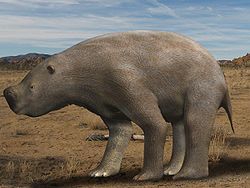 |
||
Squirrel-like
1 genus–(6 species)| Squirrel Squirrel Squirrels belong to a large family of small or medium-sized rodents called the Sciuridae. The family includes tree squirrels, ground squirrels, chipmunks, marmots , flying squirrels, and prairie dogs. Squirrels are indigenous to the Americas, Eurasia, and Africa and have been introduced to Australia... -like marsupials |
||||
|---|---|---|---|---|
| Taxa | Presence | Notes | Images | |
Marsupial Marsupial Marsupials are an infraclass of mammals, characterized by giving birth to relatively undeveloped young. Close to 70% of the 334 extant species occur in Australia, New Guinea, and nearby islands, with the remaining 100 found in the Americas, primarily in South America, but with thirteen in Central... : (squirrel-like)
|
 |
|||
Wolf-like
1 genus–(1 species)| Wolf-like marsupials | ||||
|---|---|---|---|---|
| Taxa | Presence | Notes | Images | |
Marsupial Marsupial Marsupials are an infraclass of mammals, characterized by giving birth to relatively undeveloped young. Close to 70% of the 334 extant species occur in Australia, New Guinea, and nearby islands, with the remaining 100 found in the Americas, primarily in South America, but with thirteen in Central... : (wolf-like)
|
Extinct |
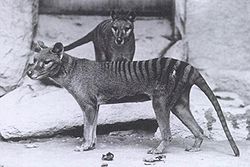 |
||
Wolverine-like
1 genus–(1 species)| Wolverine Wolverine The wolverine, pronounced , Gulo gulo , also referred to as glutton, carcajou, skunk bear, or quickhatch, is the largest land-dwelling species of the family Mustelidae . It is a stocky and muscular carnivore, more closely resembling a small bear than other mustelids... -like marsupials |
||||
|---|---|---|---|---|
| Taxa | Presence | Notes | Images | |
Marsupial Marsupial Marsupials are an infraclass of mammals, characterized by giving birth to relatively undeveloped young. Close to 70% of the 334 extant species occur in Australia, New Guinea, and nearby islands, with the remaining 100 found in the Americas, primarily in South America, but with thirteen in Central... : (wolverine-like)
|
extirpated Extinction In biology and ecology, extinction is the end of an organism or of a group of organisms , normally a species. The moment of extinction is generally considered to be the death of the last individual of the species, although the capacity to breed and recover may have been lost before this point... from mainland (Tasmania Tasmania Tasmania is an Australian island and state. It is south of the continent, separated by Bass Strait. The state includes the island of Tasmania—the 26th largest island in the world—and the surrounding islands. The state has a population of 507,626 , of whom almost half reside in the greater Hobart... only) |
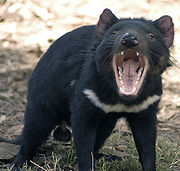 |
||
Unique:Opossum-like
? species| Unique—Opossum-like marsupials | ||||
|---|---|---|---|---|
| Taxa | Presence | Notes | Images | |
Marsupial Marsupial Marsupials are an infraclass of mammals, characterized by giving birth to relatively undeveloped young. Close to 70% of the 334 extant species occur in Australia, New Guinea, and nearby islands, with the remaining 100 found in the Americas, primarily in South America, but with thirteen in Central... : (opossum-like)
|
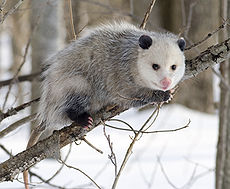 |
|||
See also
- MarsupialMarsupialMarsupials are an infraclass of mammals, characterized by giving birth to relatively undeveloped young. Close to 70% of the 334 extant species occur in Australia, New Guinea, and nearby islands, with the remaining 100 found in the Americas, primarily in South America, but with thirteen in Central...
- Island ecologyIsland EcologyIsland ecology is the study of island organisms and their interactions with each other and the environment. Islands account for nearly 1/6 of earth’s total land area, yet the ecology of island ecosystems is vastly different from that of mainland communities. Their isolation and high availability...
- BiogeographyBiogeographyBiogeography is the study of the distribution of species , organisms, and ecosystems in space and through geological time. Organisms and biological communities vary in a highly regular fashion along geographic gradients of latitude, elevation, isolation and habitat area...

